Discharge Care Plan for Angelo, a Patient with Lewy Body Dementia
VerifiedAdded on 2021/04/24
|27
|4893
|23
Report
AI Summary
This report presents a comprehensive discharge care plan for a patient diagnosed with Lewy Body Dementia, emphasizing the crucial aspects of post-hospital care. The plan begins with a thorough assessment of the patient's medical history, daily activities, and individual preferences to tailor the care package effectively. It highlights the significance of a multidisciplinary team, including healthcare professionals, family members, and social services, to ensure coordinated care. The report details the 10 steps of discharge planning, including medication management, lifestyle modifications, and the provision of necessary equipment and support services. It also underscores the importance of involving the patient's daughter in decision-making and providing her with the knowledge and resources to support her father. The plan addresses potential challenges such as medication side effects, behavioral manifestations of Lewy Body Dementia, and the need for ongoing monitoring by the general practitioner. Finally, the report stresses the benefits of family involvement and the use of a discharge checklist to facilitate a smooth transition and reduce the risk of readmission.

Running head: DISCHARGE PLANNING FOR LONG-TERM CONDITION
Discharge care plan for a patient with Lewy body disease
Name of the Student
Name of the University
Author Note
Discharge care plan for a patient with Lewy body disease
Name of the Student
Name of the University
Author Note
Paraphrase This Document
Need a fresh take? Get an instant paraphrase of this document with our AI Paraphraser
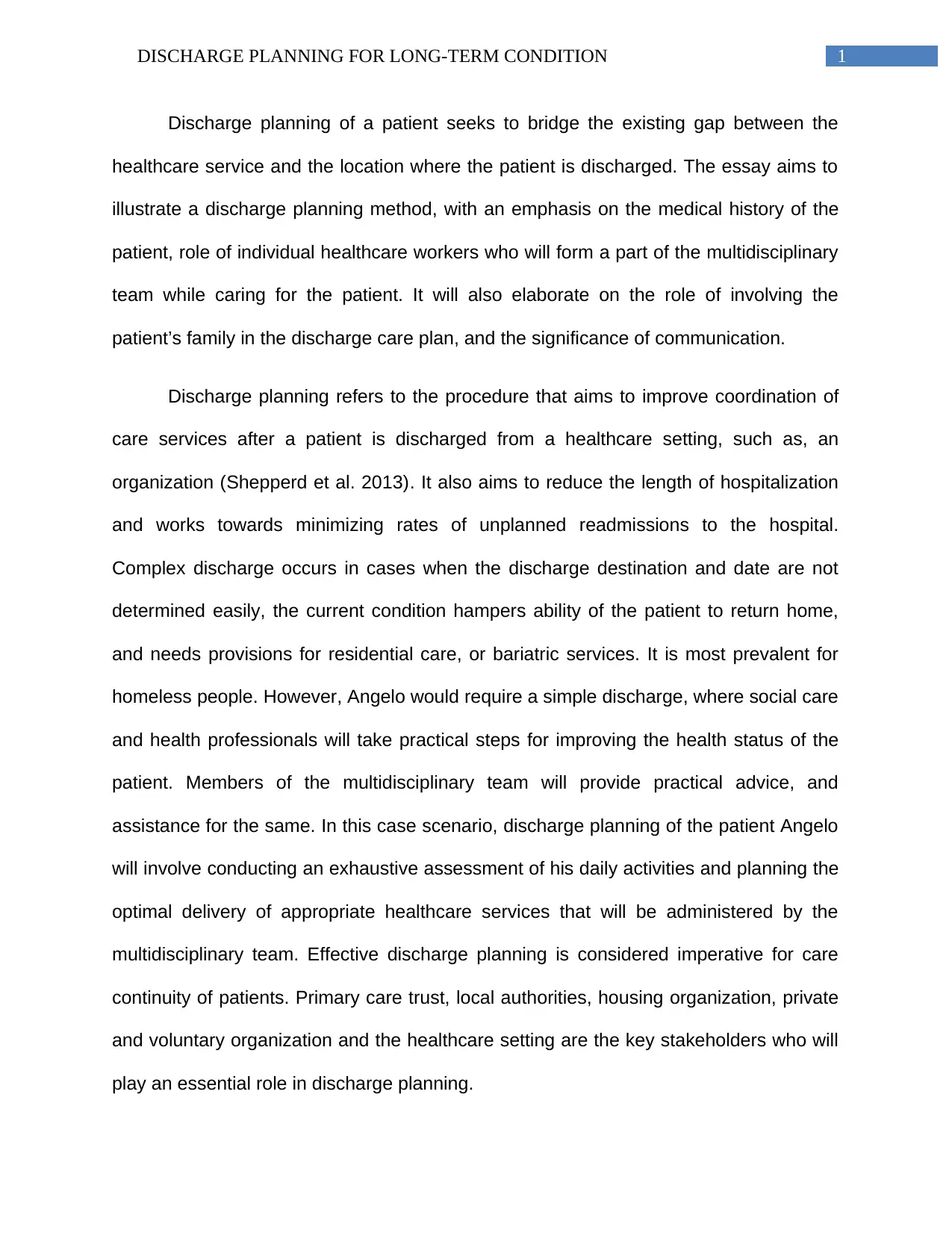
1DISCHARGE PLANNING FOR LONG-TERM CONDITION
Discharge planning of a patient seeks to bridge the existing gap between the
healthcare service and the location where the patient is discharged. The essay aims to
illustrate a discharge planning method, with an emphasis on the medical history of the
patient, role of individual healthcare workers who will form a part of the multidisciplinary
team while caring for the patient. It will also elaborate on the role of involving the
patient’s family in the discharge care plan, and the significance of communication.
Discharge planning refers to the procedure that aims to improve coordination of
care services after a patient is discharged from a healthcare setting, such as, an
organization (Shepperd et al. 2013). It also aims to reduce the length of hospitalization
and works towards minimizing rates of unplanned readmissions to the hospital.
Complex discharge occurs in cases when the discharge destination and date are not
determined easily, the current condition hampers ability of the patient to return home,
and needs provisions for residential care, or bariatric services. It is most prevalent for
homeless people. However, Angelo would require a simple discharge, where social care
and health professionals will take practical steps for improving the health status of the
patient. Members of the multidisciplinary team will provide practical advice, and
assistance for the same. In this case scenario, discharge planning of the patient Angelo
will involve conducting an exhaustive assessment of his daily activities and planning the
optimal delivery of appropriate healthcare services that will be administered by the
multidisciplinary team. Effective discharge planning is considered imperative for care
continuity of patients. Primary care trust, local authorities, housing organization, private
and voluntary organization and the healthcare setting are the key stakeholders who will
play an essential role in discharge planning.
Discharge planning of a patient seeks to bridge the existing gap between the
healthcare service and the location where the patient is discharged. The essay aims to
illustrate a discharge planning method, with an emphasis on the medical history of the
patient, role of individual healthcare workers who will form a part of the multidisciplinary
team while caring for the patient. It will also elaborate on the role of involving the
patient’s family in the discharge care plan, and the significance of communication.
Discharge planning refers to the procedure that aims to improve coordination of
care services after a patient is discharged from a healthcare setting, such as, an
organization (Shepperd et al. 2013). It also aims to reduce the length of hospitalization
and works towards minimizing rates of unplanned readmissions to the hospital.
Complex discharge occurs in cases when the discharge destination and date are not
determined easily, the current condition hampers ability of the patient to return home,
and needs provisions for residential care, or bariatric services. It is most prevalent for
homeless people. However, Angelo would require a simple discharge, where social care
and health professionals will take practical steps for improving the health status of the
patient. Members of the multidisciplinary team will provide practical advice, and
assistance for the same. In this case scenario, discharge planning of the patient Angelo
will involve conducting an exhaustive assessment of his daily activities and planning the
optimal delivery of appropriate healthcare services that will be administered by the
multidisciplinary team. Effective discharge planning is considered imperative for care
continuity of patients. Primary care trust, local authorities, housing organization, private
and voluntary organization and the healthcare setting are the key stakeholders who will
play an essential role in discharge planning.
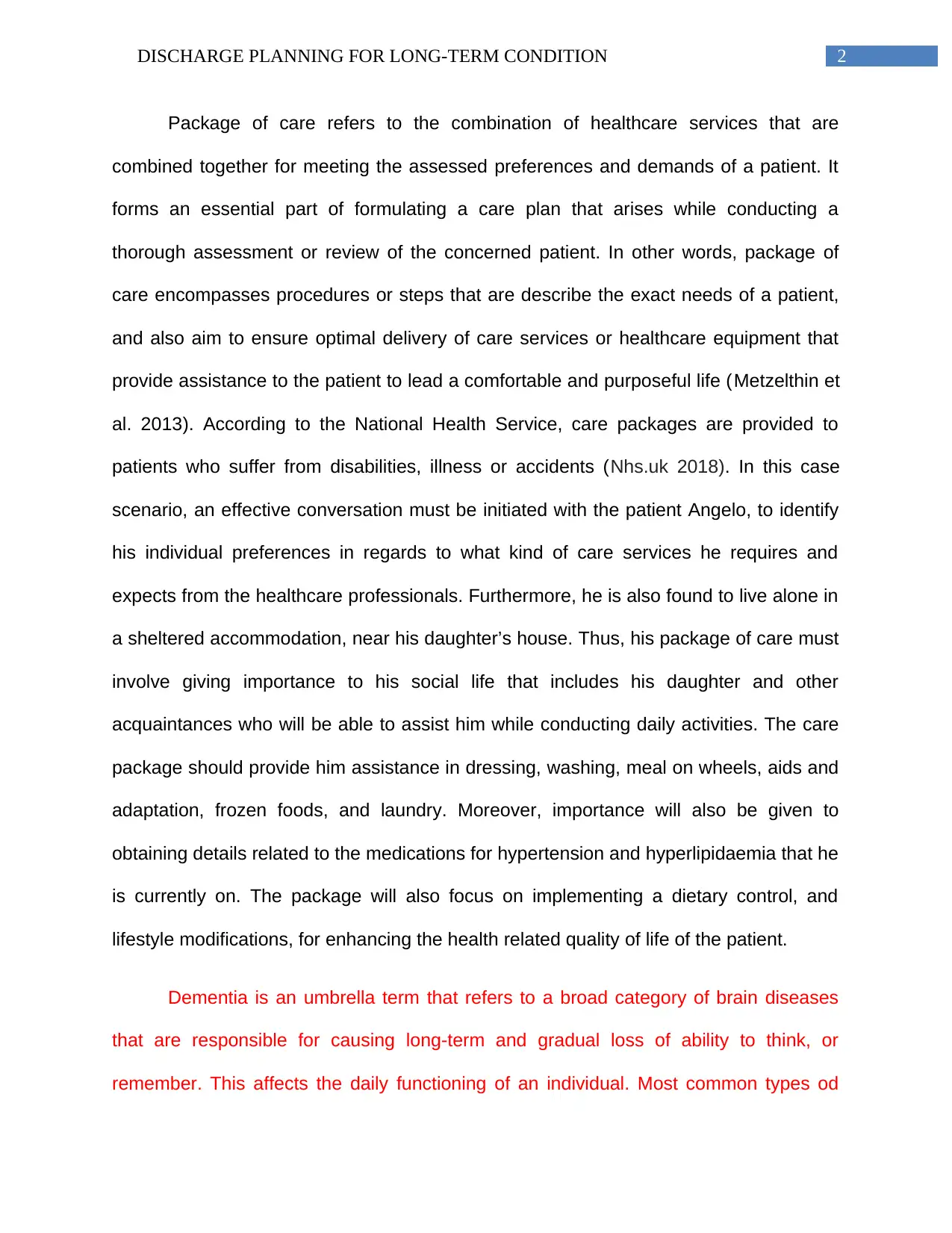
2DISCHARGE PLANNING FOR LONG-TERM CONDITION
Package of care refers to the combination of healthcare services that are
combined together for meeting the assessed preferences and demands of a patient. It
forms an essential part of formulating a care plan that arises while conducting a
thorough assessment or review of the concerned patient. In other words, package of
care encompasses procedures or steps that are describe the exact needs of a patient,
and also aim to ensure optimal delivery of care services or healthcare equipment that
provide assistance to the patient to lead a comfortable and purposeful life (Metzelthin et
al. 2013). According to the National Health Service, care packages are provided to
patients who suffer from disabilities, illness or accidents (Nhs.uk 2018). In this case
scenario, an effective conversation must be initiated with the patient Angelo, to identify
his individual preferences in regards to what kind of care services he requires and
expects from the healthcare professionals. Furthermore, he is also found to live alone in
a sheltered accommodation, near his daughter’s house. Thus, his package of care must
involve giving importance to his social life that includes his daughter and other
acquaintances who will be able to assist him while conducting daily activities. The care
package should provide him assistance in dressing, washing, meal on wheels, aids and
adaptation, frozen foods, and laundry. Moreover, importance will also be given to
obtaining details related to the medications for hypertension and hyperlipidaemia that he
is currently on. The package will also focus on implementing a dietary control, and
lifestyle modifications, for enhancing the health related quality of life of the patient.
Dementia is an umbrella term that refers to a broad category of brain diseases
that are responsible for causing long-term and gradual loss of ability to think, or
remember. This affects the daily functioning of an individual. Most common types od
Package of care refers to the combination of healthcare services that are
combined together for meeting the assessed preferences and demands of a patient. It
forms an essential part of formulating a care plan that arises while conducting a
thorough assessment or review of the concerned patient. In other words, package of
care encompasses procedures or steps that are describe the exact needs of a patient,
and also aim to ensure optimal delivery of care services or healthcare equipment that
provide assistance to the patient to lead a comfortable and purposeful life (Metzelthin et
al. 2013). According to the National Health Service, care packages are provided to
patients who suffer from disabilities, illness or accidents (Nhs.uk 2018). In this case
scenario, an effective conversation must be initiated with the patient Angelo, to identify
his individual preferences in regards to what kind of care services he requires and
expects from the healthcare professionals. Furthermore, he is also found to live alone in
a sheltered accommodation, near his daughter’s house. Thus, his package of care must
involve giving importance to his social life that includes his daughter and other
acquaintances who will be able to assist him while conducting daily activities. The care
package should provide him assistance in dressing, washing, meal on wheels, aids and
adaptation, frozen foods, and laundry. Moreover, importance will also be given to
obtaining details related to the medications for hypertension and hyperlipidaemia that he
is currently on. The package will also focus on implementing a dietary control, and
lifestyle modifications, for enhancing the health related quality of life of the patient.
Dementia is an umbrella term that refers to a broad category of brain diseases
that are responsible for causing long-term and gradual loss of ability to think, or
remember. This affects the daily functioning of an individual. Most common types od
⊘ This is a preview!⊘
Do you want full access?
Subscribe today to unlock all pages.

Trusted by 1+ million students worldwide
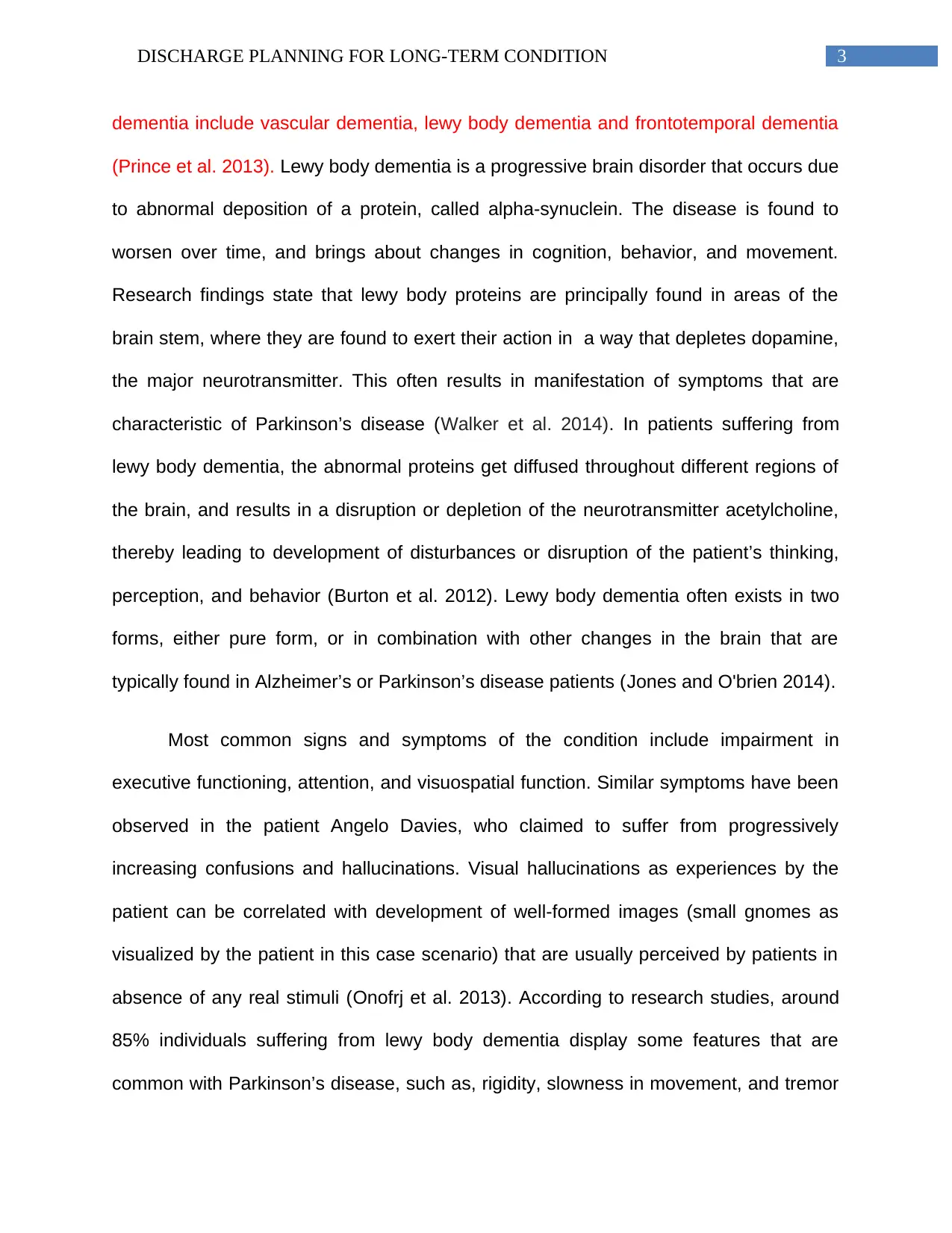
3DISCHARGE PLANNING FOR LONG-TERM CONDITION
dementia include vascular dementia, lewy body dementia and frontotemporal dementia
(Prince et al. 2013). Lewy body dementia is a progressive brain disorder that occurs due
to abnormal deposition of a protein, called alpha-synuclein. The disease is found to
worsen over time, and brings about changes in cognition, behavior, and movement.
Research findings state that lewy body proteins are principally found in areas of the
brain stem, where they are found to exert their action in a way that depletes dopamine,
the major neurotransmitter. This often results in manifestation of symptoms that are
characteristic of Parkinson’s disease (Walker et al. 2014). In patients suffering from
lewy body dementia, the abnormal proteins get diffused throughout different regions of
the brain, and results in a disruption or depletion of the neurotransmitter acetylcholine,
thereby leading to development of disturbances or disruption of the patient’s thinking,
perception, and behavior (Burton et al. 2012). Lewy body dementia often exists in two
forms, either pure form, or in combination with other changes in the brain that are
typically found in Alzheimer’s or Parkinson’s disease patients (Jones and O'brien 2014).
Most common signs and symptoms of the condition include impairment in
executive functioning, attention, and visuospatial function. Similar symptoms have been
observed in the patient Angelo Davies, who claimed to suffer from progressively
increasing confusions and hallucinations. Visual hallucinations as experiences by the
patient can be correlated with development of well-formed images (small gnomes as
visualized by the patient in this case scenario) that are usually perceived by patients in
absence of any real stimuli (Onofrj et al. 2013). According to research studies, around
85% individuals suffering from lewy body dementia display some features that are
common with Parkinson’s disease, such as, rigidity, slowness in movement, and tremor
dementia include vascular dementia, lewy body dementia and frontotemporal dementia
(Prince et al. 2013). Lewy body dementia is a progressive brain disorder that occurs due
to abnormal deposition of a protein, called alpha-synuclein. The disease is found to
worsen over time, and brings about changes in cognition, behavior, and movement.
Research findings state that lewy body proteins are principally found in areas of the
brain stem, where they are found to exert their action in a way that depletes dopamine,
the major neurotransmitter. This often results in manifestation of symptoms that are
characteristic of Parkinson’s disease (Walker et al. 2014). In patients suffering from
lewy body dementia, the abnormal proteins get diffused throughout different regions of
the brain, and results in a disruption or depletion of the neurotransmitter acetylcholine,
thereby leading to development of disturbances or disruption of the patient’s thinking,
perception, and behavior (Burton et al. 2012). Lewy body dementia often exists in two
forms, either pure form, or in combination with other changes in the brain that are
typically found in Alzheimer’s or Parkinson’s disease patients (Jones and O'brien 2014).
Most common signs and symptoms of the condition include impairment in
executive functioning, attention, and visuospatial function. Similar symptoms have been
observed in the patient Angelo Davies, who claimed to suffer from progressively
increasing confusions and hallucinations. Visual hallucinations as experiences by the
patient can be correlated with development of well-formed images (small gnomes as
visualized by the patient in this case scenario) that are usually perceived by patients in
absence of any real stimuli (Onofrj et al. 2013). According to research studies, around
85% individuals suffering from lewy body dementia display some features that are
common with Parkinson’s disease, such as, rigidity, slowness in movement, and tremor
Paraphrase This Document
Need a fresh take? Get an instant paraphrase of this document with our AI Paraphraser
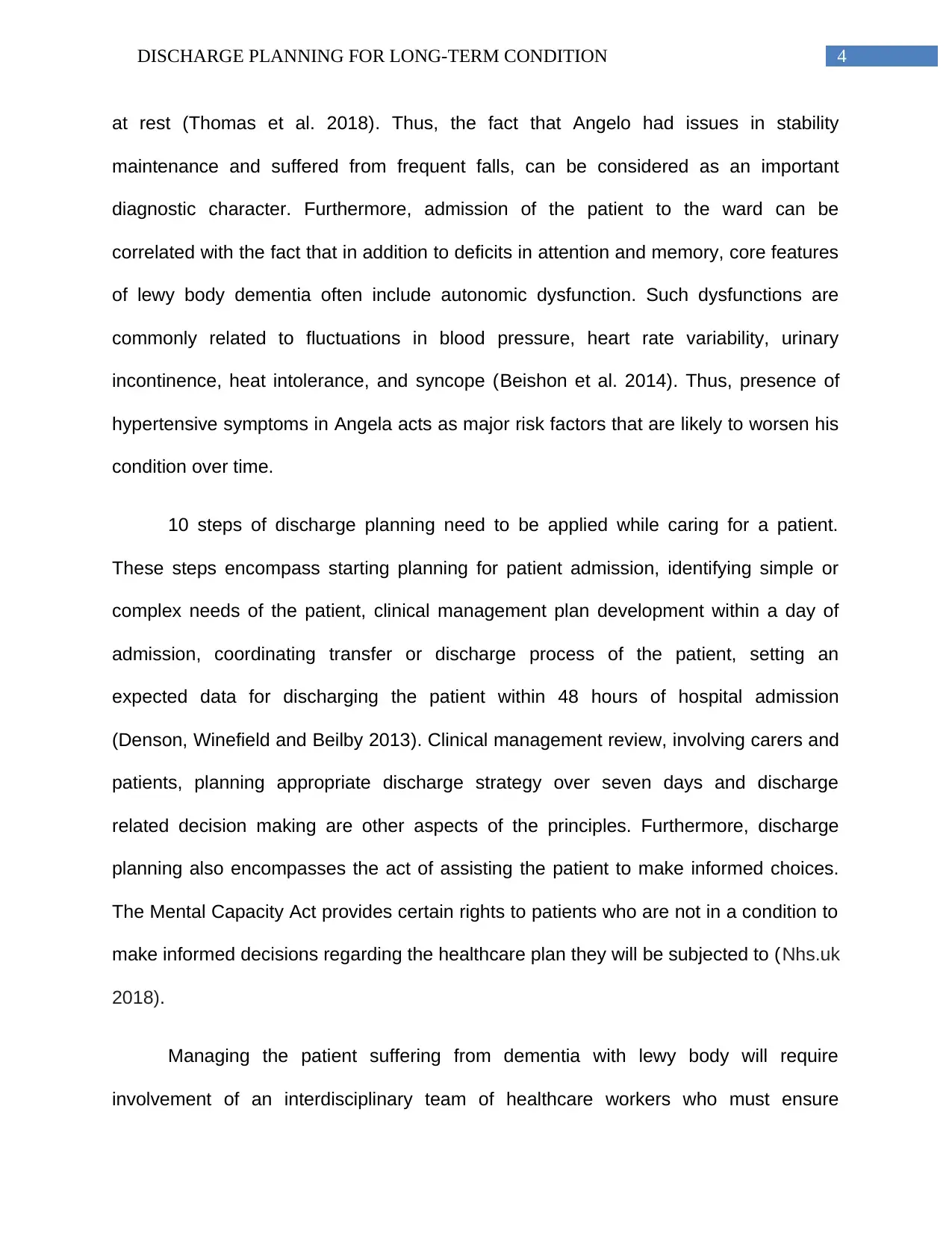
4DISCHARGE PLANNING FOR LONG-TERM CONDITION
at rest (Thomas et al. 2018). Thus, the fact that Angelo had issues in stability
maintenance and suffered from frequent falls, can be considered as an important
diagnostic character. Furthermore, admission of the patient to the ward can be
correlated with the fact that in addition to deficits in attention and memory, core features
of lewy body dementia often include autonomic dysfunction. Such dysfunctions are
commonly related to fluctuations in blood pressure, heart rate variability, urinary
incontinence, heat intolerance, and syncope (Beishon et al. 2014). Thus, presence of
hypertensive symptoms in Angela acts as major risk factors that are likely to worsen his
condition over time.
10 steps of discharge planning need to be applied while caring for a patient.
These steps encompass starting planning for patient admission, identifying simple or
complex needs of the patient, clinical management plan development within a day of
admission, coordinating transfer or discharge process of the patient, setting an
expected data for discharging the patient within 48 hours of hospital admission
(Denson, Winefield and Beilby 2013). Clinical management review, involving carers and
patients, planning appropriate discharge strategy over seven days and discharge
related decision making are other aspects of the principles. Furthermore, discharge
planning also encompasses the act of assisting the patient to make informed choices.
The Mental Capacity Act provides certain rights to patients who are not in a condition to
make informed decisions regarding the healthcare plan they will be subjected to (Nhs.uk
2018).
Managing the patient suffering from dementia with lewy body will require
involvement of an interdisciplinary team of healthcare workers who must ensure
at rest (Thomas et al. 2018). Thus, the fact that Angelo had issues in stability
maintenance and suffered from frequent falls, can be considered as an important
diagnostic character. Furthermore, admission of the patient to the ward can be
correlated with the fact that in addition to deficits in attention and memory, core features
of lewy body dementia often include autonomic dysfunction. Such dysfunctions are
commonly related to fluctuations in blood pressure, heart rate variability, urinary
incontinence, heat intolerance, and syncope (Beishon et al. 2014). Thus, presence of
hypertensive symptoms in Angela acts as major risk factors that are likely to worsen his
condition over time.
10 steps of discharge planning need to be applied while caring for a patient.
These steps encompass starting planning for patient admission, identifying simple or
complex needs of the patient, clinical management plan development within a day of
admission, coordinating transfer or discharge process of the patient, setting an
expected data for discharging the patient within 48 hours of hospital admission
(Denson, Winefield and Beilby 2013). Clinical management review, involving carers and
patients, planning appropriate discharge strategy over seven days and discharge
related decision making are other aspects of the principles. Furthermore, discharge
planning also encompasses the act of assisting the patient to make informed choices.
The Mental Capacity Act provides certain rights to patients who are not in a condition to
make informed decisions regarding the healthcare plan they will be subjected to (Nhs.uk
2018).
Managing the patient suffering from dementia with lewy body will require
involvement of an interdisciplinary team of healthcare workers who must ensure
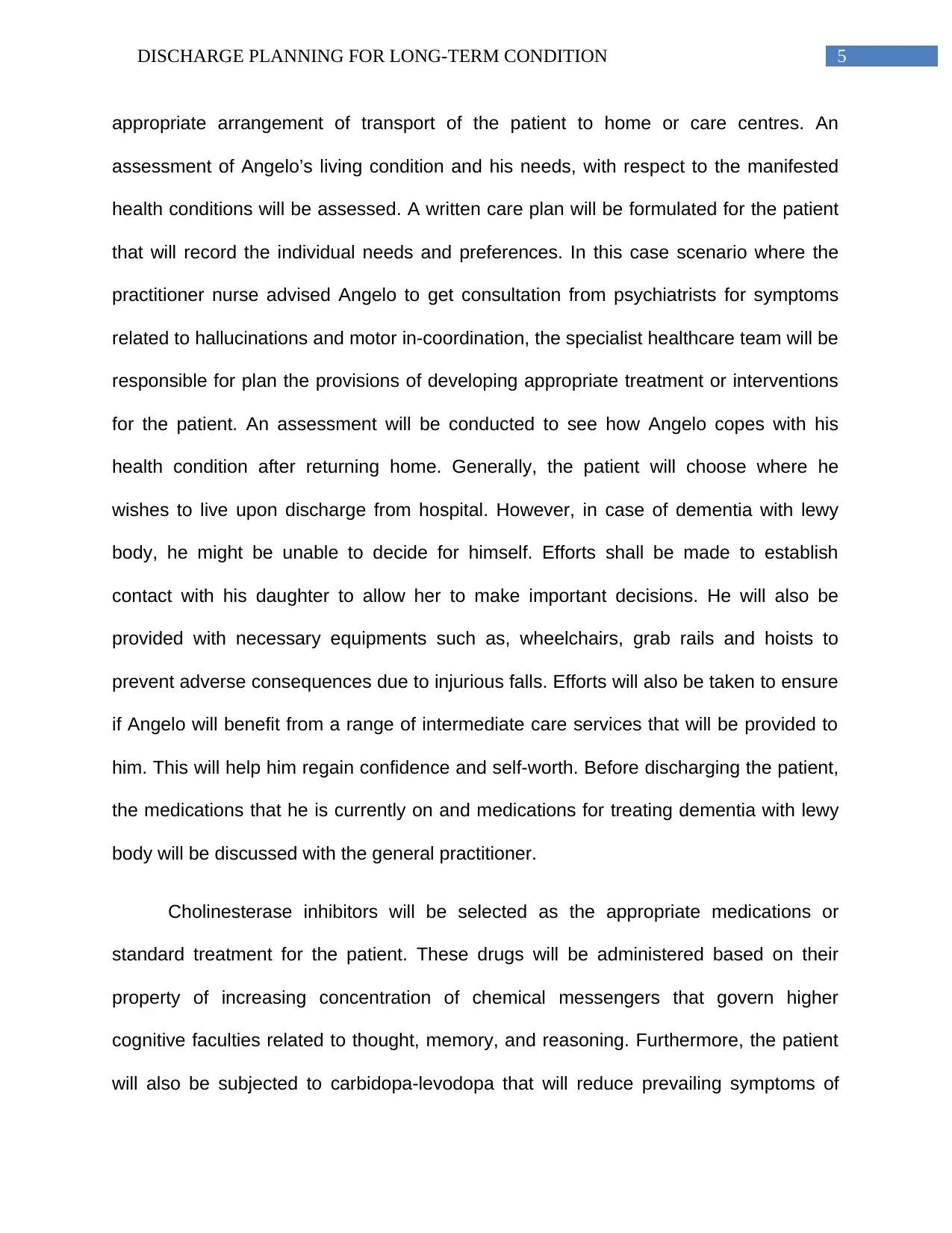
5DISCHARGE PLANNING FOR LONG-TERM CONDITION
appropriate arrangement of transport of the patient to home or care centres. An
assessment of Angelo’s living condition and his needs, with respect to the manifested
health conditions will be assessed. A written care plan will be formulated for the patient
that will record the individual needs and preferences. In this case scenario where the
practitioner nurse advised Angelo to get consultation from psychiatrists for symptoms
related to hallucinations and motor in-coordination, the specialist healthcare team will be
responsible for plan the provisions of developing appropriate treatment or interventions
for the patient. An assessment will be conducted to see how Angelo copes with his
health condition after returning home. Generally, the patient will choose where he
wishes to live upon discharge from hospital. However, in case of dementia with lewy
body, he might be unable to decide for himself. Efforts shall be made to establish
contact with his daughter to allow her to make important decisions. He will also be
provided with necessary equipments such as, wheelchairs, grab rails and hoists to
prevent adverse consequences due to injurious falls. Efforts will also be taken to ensure
if Angelo will benefit from a range of intermediate care services that will be provided to
him. This will help him regain confidence and self-worth. Before discharging the patient,
the medications that he is currently on and medications for treating dementia with lewy
body will be discussed with the general practitioner.
Cholinesterase inhibitors will be selected as the appropriate medications or
standard treatment for the patient. These drugs will be administered based on their
property of increasing concentration of chemical messengers that govern higher
cognitive faculties related to thought, memory, and reasoning. Furthermore, the patient
will also be subjected to carbidopa-levodopa that will reduce prevailing symptoms of
appropriate arrangement of transport of the patient to home or care centres. An
assessment of Angelo’s living condition and his needs, with respect to the manifested
health conditions will be assessed. A written care plan will be formulated for the patient
that will record the individual needs and preferences. In this case scenario where the
practitioner nurse advised Angelo to get consultation from psychiatrists for symptoms
related to hallucinations and motor in-coordination, the specialist healthcare team will be
responsible for plan the provisions of developing appropriate treatment or interventions
for the patient. An assessment will be conducted to see how Angelo copes with his
health condition after returning home. Generally, the patient will choose where he
wishes to live upon discharge from hospital. However, in case of dementia with lewy
body, he might be unable to decide for himself. Efforts shall be made to establish
contact with his daughter to allow her to make important decisions. He will also be
provided with necessary equipments such as, wheelchairs, grab rails and hoists to
prevent adverse consequences due to injurious falls. Efforts will also be taken to ensure
if Angelo will benefit from a range of intermediate care services that will be provided to
him. This will help him regain confidence and self-worth. Before discharging the patient,
the medications that he is currently on and medications for treating dementia with lewy
body will be discussed with the general practitioner.
Cholinesterase inhibitors will be selected as the appropriate medications or
standard treatment for the patient. These drugs will be administered based on their
property of increasing concentration of chemical messengers that govern higher
cognitive faculties related to thought, memory, and reasoning. Furthermore, the patient
will also be subjected to carbidopa-levodopa that will reduce prevailing symptoms of
⊘ This is a preview!⊘
Do you want full access?
Subscribe today to unlock all pages.

Trusted by 1+ million students worldwide
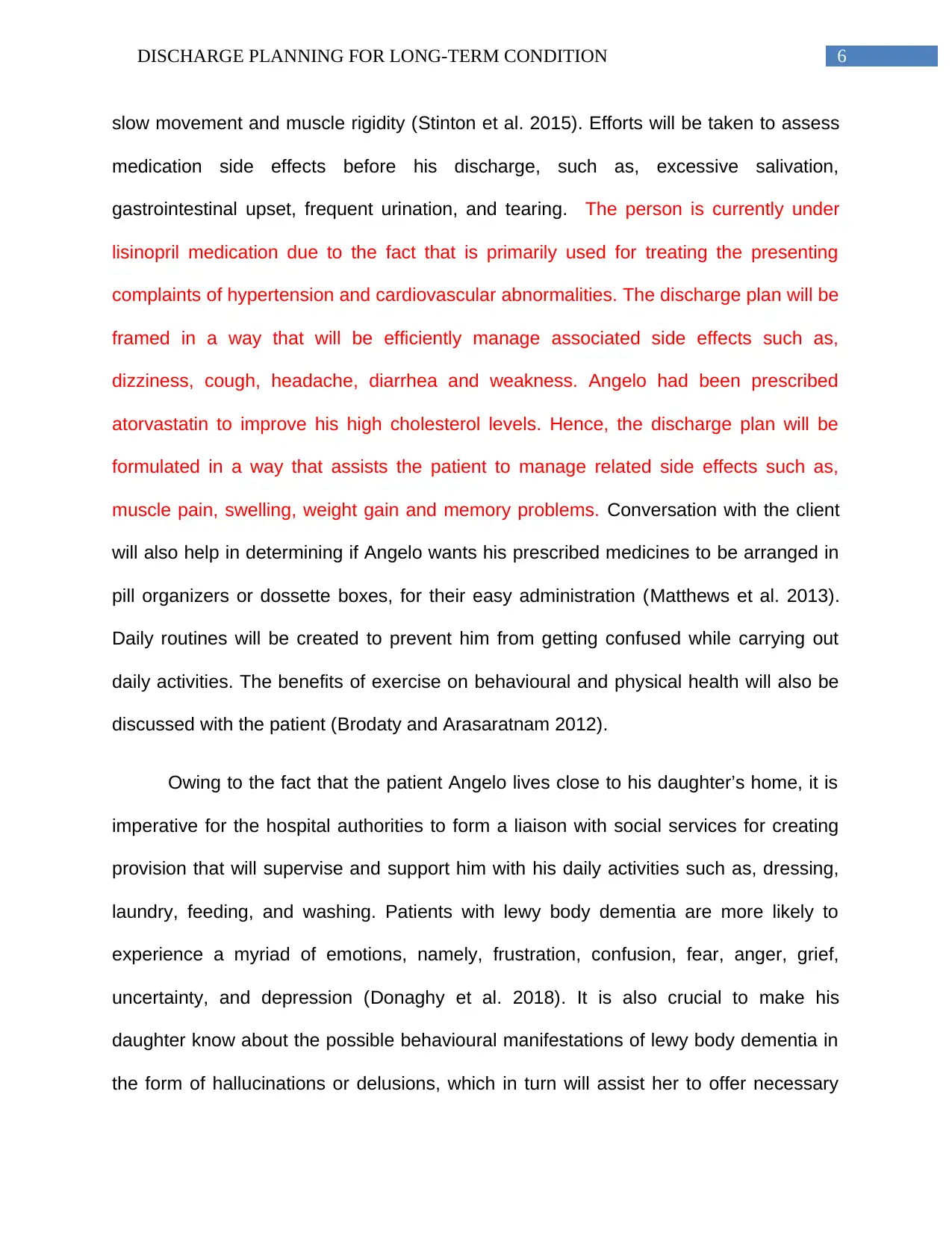
6DISCHARGE PLANNING FOR LONG-TERM CONDITION
slow movement and muscle rigidity (Stinton et al. 2015). Efforts will be taken to assess
medication side effects before his discharge, such as, excessive salivation,
gastrointestinal upset, frequent urination, and tearing. The person is currently under
lisinopril medication due to the fact that is primarily used for treating the presenting
complaints of hypertension and cardiovascular abnormalities. The discharge plan will be
framed in a way that will be efficiently manage associated side effects such as,
dizziness, cough, headache, diarrhea and weakness. Angelo had been prescribed
atorvastatin to improve his high cholesterol levels. Hence, the discharge plan will be
formulated in a way that assists the patient to manage related side effects such as,
muscle pain, swelling, weight gain and memory problems. Conversation with the client
will also help in determining if Angelo wants his prescribed medicines to be arranged in
pill organizers or dossette boxes, for their easy administration (Matthews et al. 2013).
Daily routines will be created to prevent him from getting confused while carrying out
daily activities. The benefits of exercise on behavioural and physical health will also be
discussed with the patient (Brodaty and Arasaratnam 2012).
Owing to the fact that the patient Angelo lives close to his daughter’s home, it is
imperative for the hospital authorities to form a liaison with social services for creating
provision that will supervise and support him with his daily activities such as, dressing,
laundry, feeding, and washing. Patients with lewy body dementia are more likely to
experience a myriad of emotions, namely, frustration, confusion, fear, anger, grief,
uncertainty, and depression (Donaghy et al. 2018). It is also crucial to make his
daughter know about the possible behavioural manifestations of lewy body dementia in
the form of hallucinations or delusions, which in turn will assist her to offer necessary
slow movement and muscle rigidity (Stinton et al. 2015). Efforts will be taken to assess
medication side effects before his discharge, such as, excessive salivation,
gastrointestinal upset, frequent urination, and tearing. The person is currently under
lisinopril medication due to the fact that is primarily used for treating the presenting
complaints of hypertension and cardiovascular abnormalities. The discharge plan will be
framed in a way that will be efficiently manage associated side effects such as,
dizziness, cough, headache, diarrhea and weakness. Angelo had been prescribed
atorvastatin to improve his high cholesterol levels. Hence, the discharge plan will be
formulated in a way that assists the patient to manage related side effects such as,
muscle pain, swelling, weight gain and memory problems. Conversation with the client
will also help in determining if Angelo wants his prescribed medicines to be arranged in
pill organizers or dossette boxes, for their easy administration (Matthews et al. 2013).
Daily routines will be created to prevent him from getting confused while carrying out
daily activities. The benefits of exercise on behavioural and physical health will also be
discussed with the patient (Brodaty and Arasaratnam 2012).
Owing to the fact that the patient Angelo lives close to his daughter’s home, it is
imperative for the hospital authorities to form a liaison with social services for creating
provision that will supervise and support him with his daily activities such as, dressing,
laundry, feeding, and washing. Patients with lewy body dementia are more likely to
experience a myriad of emotions, namely, frustration, confusion, fear, anger, grief,
uncertainty, and depression (Donaghy et al. 2018). It is also crucial to make his
daughter know about the possible behavioural manifestations of lewy body dementia in
the form of hallucinations or delusions, which in turn will assist her to offer necessary
Paraphrase This Document
Need a fresh take? Get an instant paraphrase of this document with our AI Paraphraser
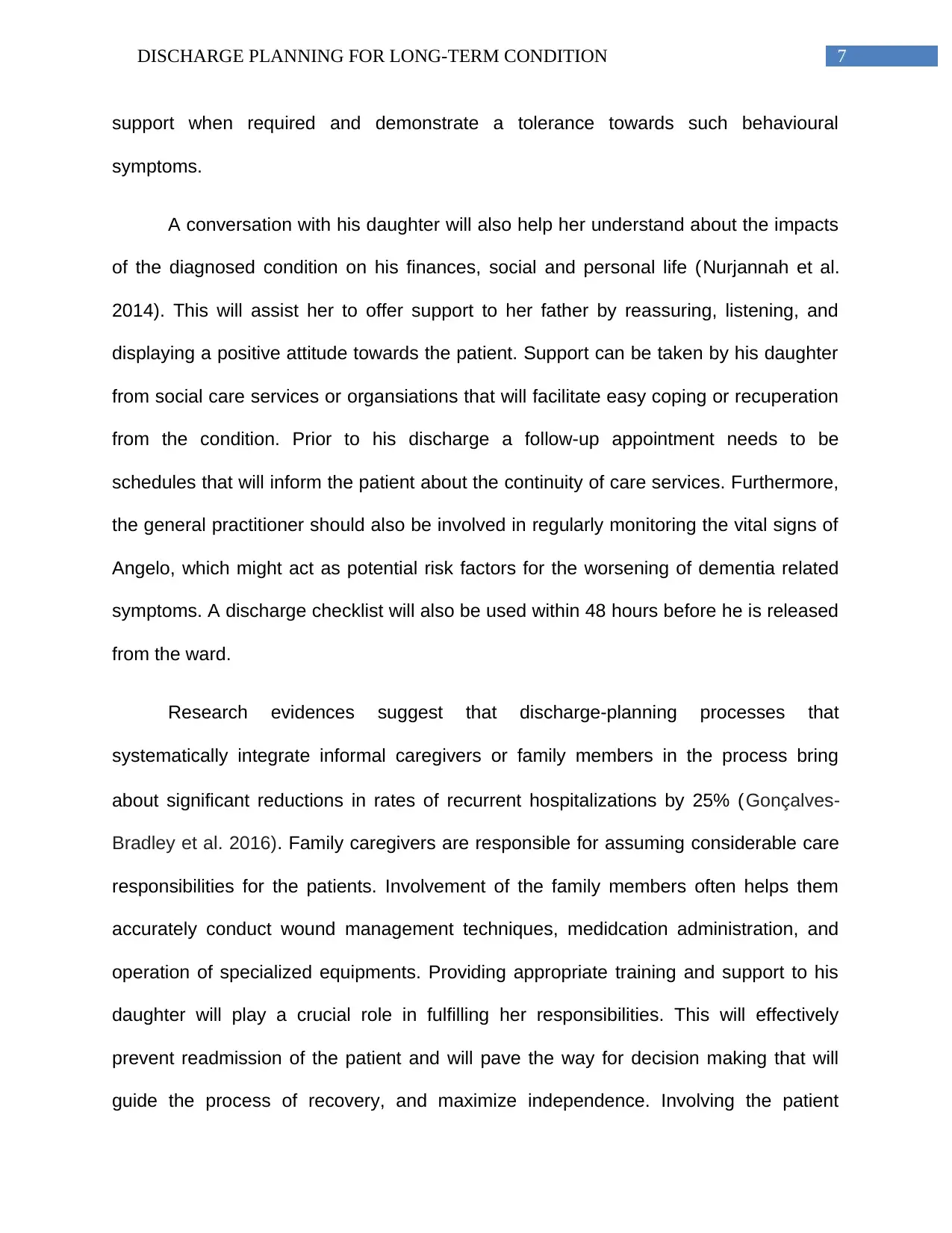
7DISCHARGE PLANNING FOR LONG-TERM CONDITION
support when required and demonstrate a tolerance towards such behavioural
symptoms.
A conversation with his daughter will also help her understand about the impacts
of the diagnosed condition on his finances, social and personal life (Nurjannah et al.
2014). This will assist her to offer support to her father by reassuring, listening, and
displaying a positive attitude towards the patient. Support can be taken by his daughter
from social care services or organsiations that will facilitate easy coping or recuperation
from the condition. Prior to his discharge a follow-up appointment needs to be
schedules that will inform the patient about the continuity of care services. Furthermore,
the general practitioner should also be involved in regularly monitoring the vital signs of
Angelo, which might act as potential risk factors for the worsening of dementia related
symptoms. A discharge checklist will also be used within 48 hours before he is released
from the ward.
Research evidences suggest that discharge-planning processes that
systematically integrate informal caregivers or family members in the process bring
about significant reductions in rates of recurrent hospitalizations by 25% (Gonçalves‐
Bradley et al. 2016). Family caregivers are responsible for assuming considerable care
responsibilities for the patients. Involvement of the family members often helps them
accurately conduct wound management techniques, medidcation administration, and
operation of specialized equipments. Providing appropriate training and support to his
daughter will play a crucial role in fulfilling her responsibilities. This will effectively
prevent readmission of the patient and will pave the way for decision making that will
guide the process of recovery, and maximize independence. Involving the patient
support when required and demonstrate a tolerance towards such behavioural
symptoms.
A conversation with his daughter will also help her understand about the impacts
of the diagnosed condition on his finances, social and personal life (Nurjannah et al.
2014). This will assist her to offer support to her father by reassuring, listening, and
displaying a positive attitude towards the patient. Support can be taken by his daughter
from social care services or organsiations that will facilitate easy coping or recuperation
from the condition. Prior to his discharge a follow-up appointment needs to be
schedules that will inform the patient about the continuity of care services. Furthermore,
the general practitioner should also be involved in regularly monitoring the vital signs of
Angelo, which might act as potential risk factors for the worsening of dementia related
symptoms. A discharge checklist will also be used within 48 hours before he is released
from the ward.
Research evidences suggest that discharge-planning processes that
systematically integrate informal caregivers or family members in the process bring
about significant reductions in rates of recurrent hospitalizations by 25% (Gonçalves‐
Bradley et al. 2016). Family caregivers are responsible for assuming considerable care
responsibilities for the patients. Involvement of the family members often helps them
accurately conduct wound management techniques, medidcation administration, and
operation of specialized equipments. Providing appropriate training and support to his
daughter will play a crucial role in fulfilling her responsibilities. This will effectively
prevent readmission of the patient and will pave the way for decision making that will
guide the process of recovery, and maximize independence. Involving the patient
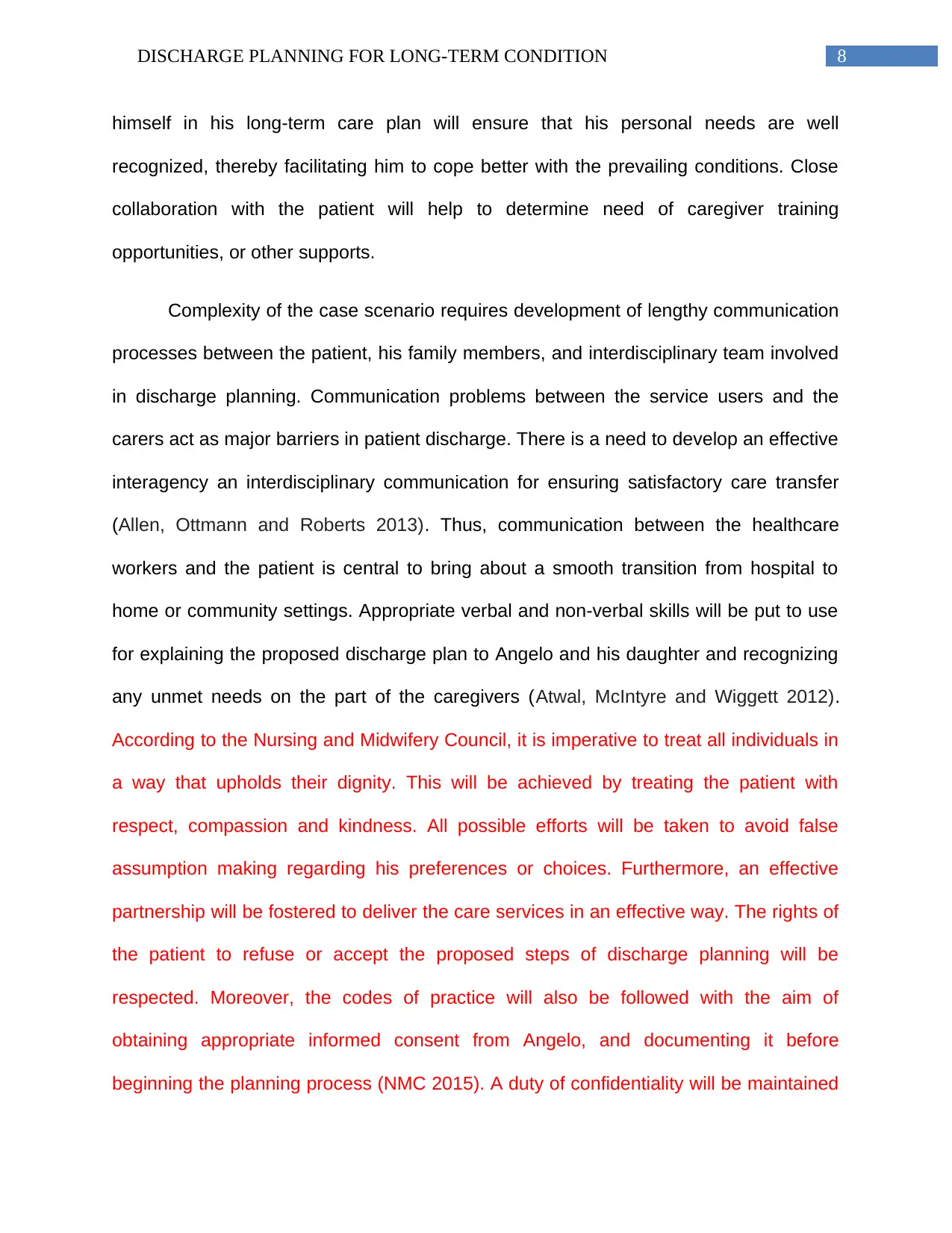
8DISCHARGE PLANNING FOR LONG-TERM CONDITION
himself in his long-term care plan will ensure that his personal needs are well
recognized, thereby facilitating him to cope better with the prevailing conditions. Close
collaboration with the patient will help to determine need of caregiver training
opportunities, or other supports.
Complexity of the case scenario requires development of lengthy communication
processes between the patient, his family members, and interdisciplinary team involved
in discharge planning. Communication problems between the service users and the
carers act as major barriers in patient discharge. There is a need to develop an effective
interagency an interdisciplinary communication for ensuring satisfactory care transfer
(Allen, Ottmann and Roberts 2013). Thus, communication between the healthcare
workers and the patient is central to bring about a smooth transition from hospital to
home or community settings. Appropriate verbal and non-verbal skills will be put to use
for explaining the proposed discharge plan to Angelo and his daughter and recognizing
any unmet needs on the part of the caregivers (Atwal, McIntyre and Wiggett 2012).
According to the Nursing and Midwifery Council, it is imperative to treat all individuals in
a way that upholds their dignity. This will be achieved by treating the patient with
respect, compassion and kindness. All possible efforts will be taken to avoid false
assumption making regarding his preferences or choices. Furthermore, an effective
partnership will be fostered to deliver the care services in an effective way. The rights of
the patient to refuse or accept the proposed steps of discharge planning will be
respected. Moreover, the codes of practice will also be followed with the aim of
obtaining appropriate informed consent from Angelo, and documenting it before
beginning the planning process (NMC 2015). A duty of confidentiality will be maintained
himself in his long-term care plan will ensure that his personal needs are well
recognized, thereby facilitating him to cope better with the prevailing conditions. Close
collaboration with the patient will help to determine need of caregiver training
opportunities, or other supports.
Complexity of the case scenario requires development of lengthy communication
processes between the patient, his family members, and interdisciplinary team involved
in discharge planning. Communication problems between the service users and the
carers act as major barriers in patient discharge. There is a need to develop an effective
interagency an interdisciplinary communication for ensuring satisfactory care transfer
(Allen, Ottmann and Roberts 2013). Thus, communication between the healthcare
workers and the patient is central to bring about a smooth transition from hospital to
home or community settings. Appropriate verbal and non-verbal skills will be put to use
for explaining the proposed discharge plan to Angelo and his daughter and recognizing
any unmet needs on the part of the caregivers (Atwal, McIntyre and Wiggett 2012).
According to the Nursing and Midwifery Council, it is imperative to treat all individuals in
a way that upholds their dignity. This will be achieved by treating the patient with
respect, compassion and kindness. All possible efforts will be taken to avoid false
assumption making regarding his preferences or choices. Furthermore, an effective
partnership will be fostered to deliver the care services in an effective way. The rights of
the patient to refuse or accept the proposed steps of discharge planning will be
respected. Moreover, the codes of practice will also be followed with the aim of
obtaining appropriate informed consent from Angelo, and documenting it before
beginning the planning process (NMC 2015). A duty of confidentiality will be maintained
⊘ This is a preview!⊘
Do you want full access?
Subscribe today to unlock all pages.

Trusted by 1+ million students worldwide
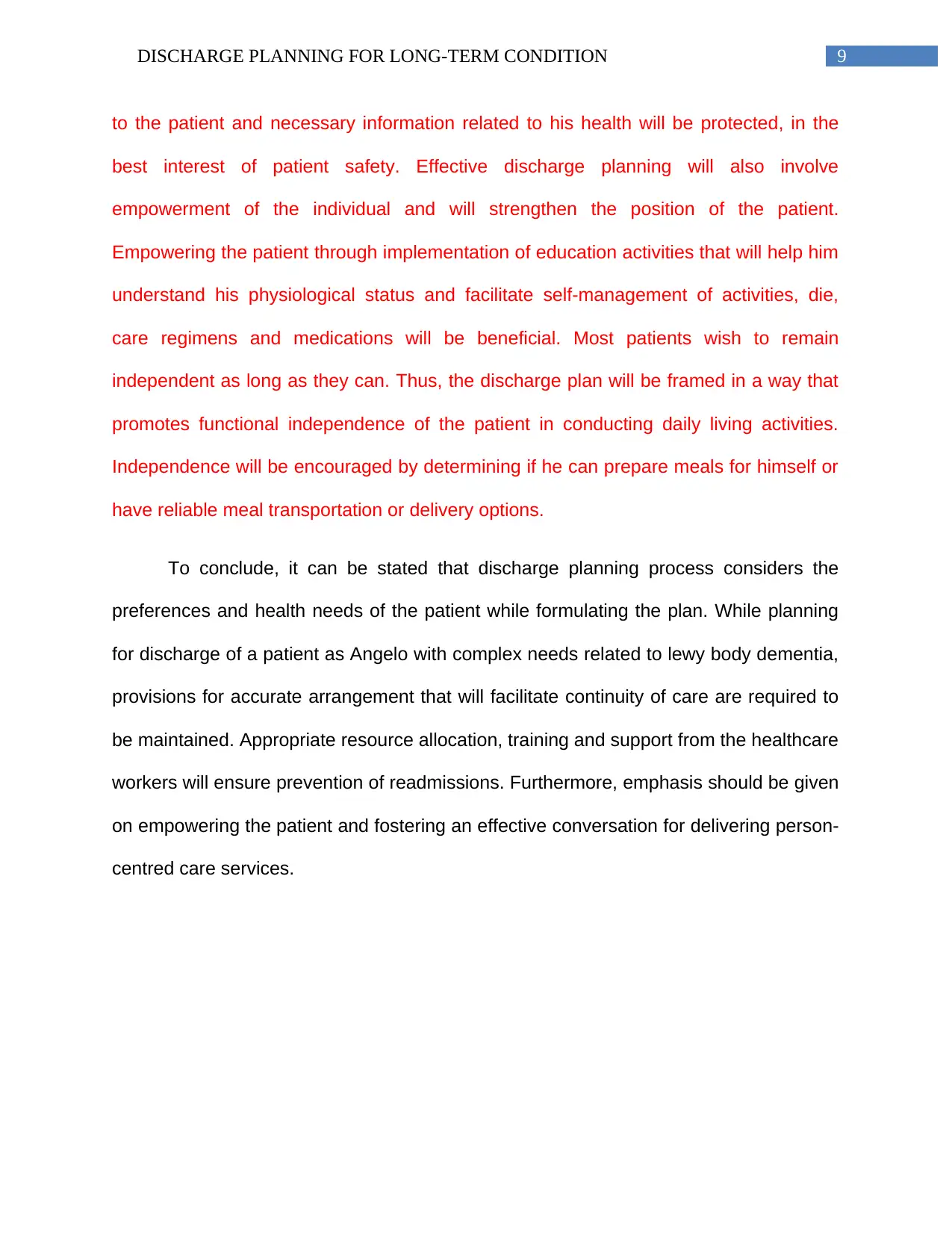
9DISCHARGE PLANNING FOR LONG-TERM CONDITION
to the patient and necessary information related to his health will be protected, in the
best interest of patient safety. Effective discharge planning will also involve
empowerment of the individual and will strengthen the position of the patient.
Empowering the patient through implementation of education activities that will help him
understand his physiological status and facilitate self-management of activities, die,
care regimens and medications will be beneficial. Most patients wish to remain
independent as long as they can. Thus, the discharge plan will be framed in a way that
promotes functional independence of the patient in conducting daily living activities.
Independence will be encouraged by determining if he can prepare meals for himself or
have reliable meal transportation or delivery options.
To conclude, it can be stated that discharge planning process considers the
preferences and health needs of the patient while formulating the plan. While planning
for discharge of a patient as Angelo with complex needs related to lewy body dementia,
provisions for accurate arrangement that will facilitate continuity of care are required to
be maintained. Appropriate resource allocation, training and support from the healthcare
workers will ensure prevention of readmissions. Furthermore, emphasis should be given
on empowering the patient and fostering an effective conversation for delivering person-
centred care services.
to the patient and necessary information related to his health will be protected, in the
best interest of patient safety. Effective discharge planning will also involve
empowerment of the individual and will strengthen the position of the patient.
Empowering the patient through implementation of education activities that will help him
understand his physiological status and facilitate self-management of activities, die,
care regimens and medications will be beneficial. Most patients wish to remain
independent as long as they can. Thus, the discharge plan will be framed in a way that
promotes functional independence of the patient in conducting daily living activities.
Independence will be encouraged by determining if he can prepare meals for himself or
have reliable meal transportation or delivery options.
To conclude, it can be stated that discharge planning process considers the
preferences and health needs of the patient while formulating the plan. While planning
for discharge of a patient as Angelo with complex needs related to lewy body dementia,
provisions for accurate arrangement that will facilitate continuity of care are required to
be maintained. Appropriate resource allocation, training and support from the healthcare
workers will ensure prevention of readmissions. Furthermore, emphasis should be given
on empowering the patient and fostering an effective conversation for delivering person-
centred care services.
Paraphrase This Document
Need a fresh take? Get an instant paraphrase of this document with our AI Paraphraser
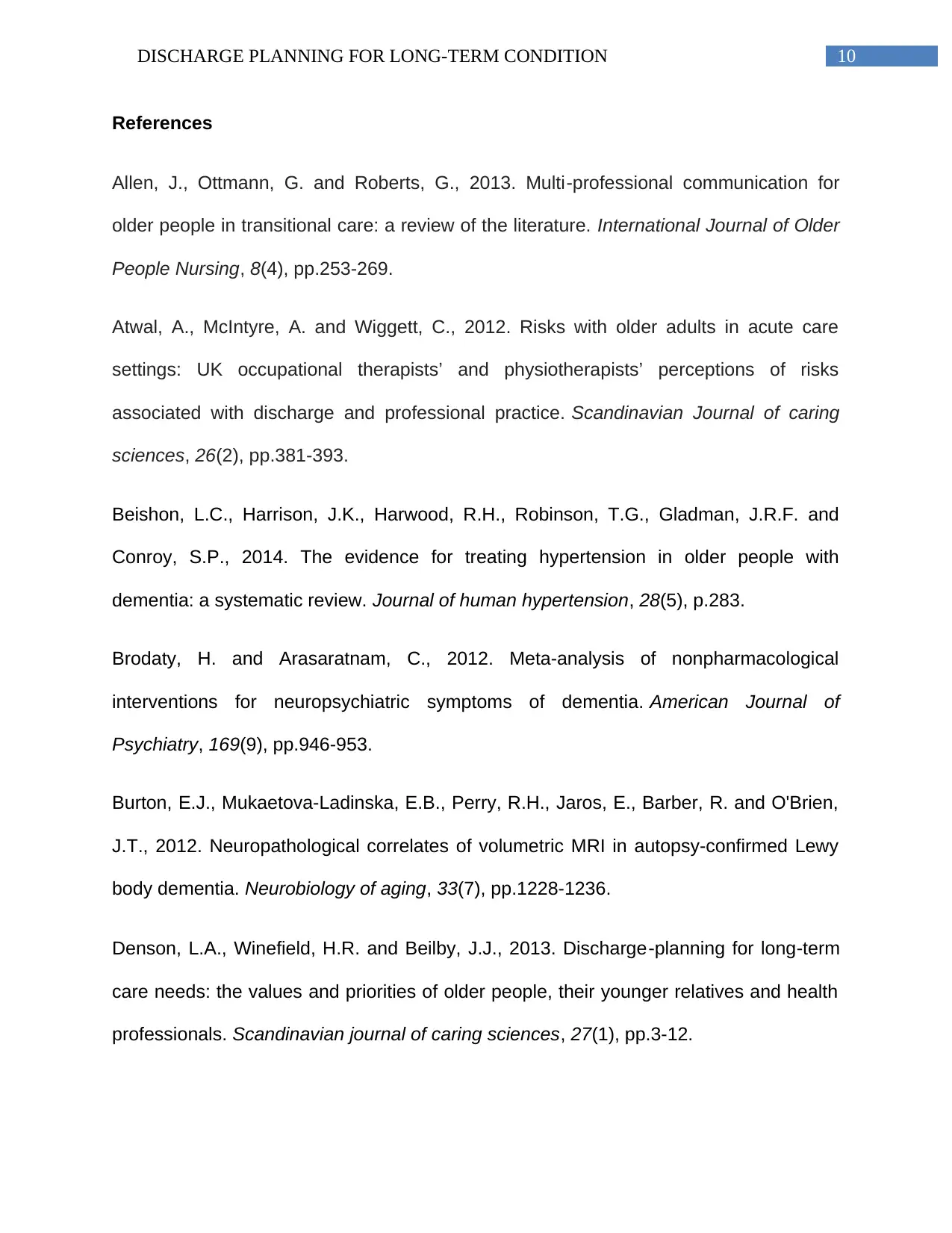
10DISCHARGE PLANNING FOR LONG-TERM CONDITION
References
Allen, J., Ottmann, G. and Roberts, G., 2013. Multi‐professional communication for
older people in transitional care: a review of the literature. International Journal of Older
People Nursing, 8(4), pp.253-269.
Atwal, A., McIntyre, A. and Wiggett, C., 2012. Risks with older adults in acute care
settings: UK occupational therapists’ and physiotherapists’ perceptions of risks
associated with discharge and professional practice. Scandinavian Journal of caring
sciences, 26(2), pp.381-393.
Beishon, L.C., Harrison, J.K., Harwood, R.H., Robinson, T.G., Gladman, J.R.F. and
Conroy, S.P., 2014. The evidence for treating hypertension in older people with
dementia: a systematic review. Journal of human hypertension, 28(5), p.283.
Brodaty, H. and Arasaratnam, C., 2012. Meta-analysis of nonpharmacological
interventions for neuropsychiatric symptoms of dementia. American Journal of
Psychiatry, 169(9), pp.946-953.
Burton, E.J., Mukaetova-Ladinska, E.B., Perry, R.H., Jaros, E., Barber, R. and O'Brien,
J.T., 2012. Neuropathological correlates of volumetric MRI in autopsy-confirmed Lewy
body dementia. Neurobiology of aging, 33(7), pp.1228-1236.
Denson, L.A., Winefield, H.R. and Beilby, J.J., 2013. Discharge‐planning for long‐term
care needs: the values and priorities of older people, their younger relatives and health
professionals. Scandinavian journal of caring sciences, 27(1), pp.3-12.
References
Allen, J., Ottmann, G. and Roberts, G., 2013. Multi‐professional communication for
older people in transitional care: a review of the literature. International Journal of Older
People Nursing, 8(4), pp.253-269.
Atwal, A., McIntyre, A. and Wiggett, C., 2012. Risks with older adults in acute care
settings: UK occupational therapists’ and physiotherapists’ perceptions of risks
associated with discharge and professional practice. Scandinavian Journal of caring
sciences, 26(2), pp.381-393.
Beishon, L.C., Harrison, J.K., Harwood, R.H., Robinson, T.G., Gladman, J.R.F. and
Conroy, S.P., 2014. The evidence for treating hypertension in older people with
dementia: a systematic review. Journal of human hypertension, 28(5), p.283.
Brodaty, H. and Arasaratnam, C., 2012. Meta-analysis of nonpharmacological
interventions for neuropsychiatric symptoms of dementia. American Journal of
Psychiatry, 169(9), pp.946-953.
Burton, E.J., Mukaetova-Ladinska, E.B., Perry, R.H., Jaros, E., Barber, R. and O'Brien,
J.T., 2012. Neuropathological correlates of volumetric MRI in autopsy-confirmed Lewy
body dementia. Neurobiology of aging, 33(7), pp.1228-1236.
Denson, L.A., Winefield, H.R. and Beilby, J.J., 2013. Discharge‐planning for long‐term
care needs: the values and priorities of older people, their younger relatives and health
professionals. Scandinavian journal of caring sciences, 27(1), pp.3-12.
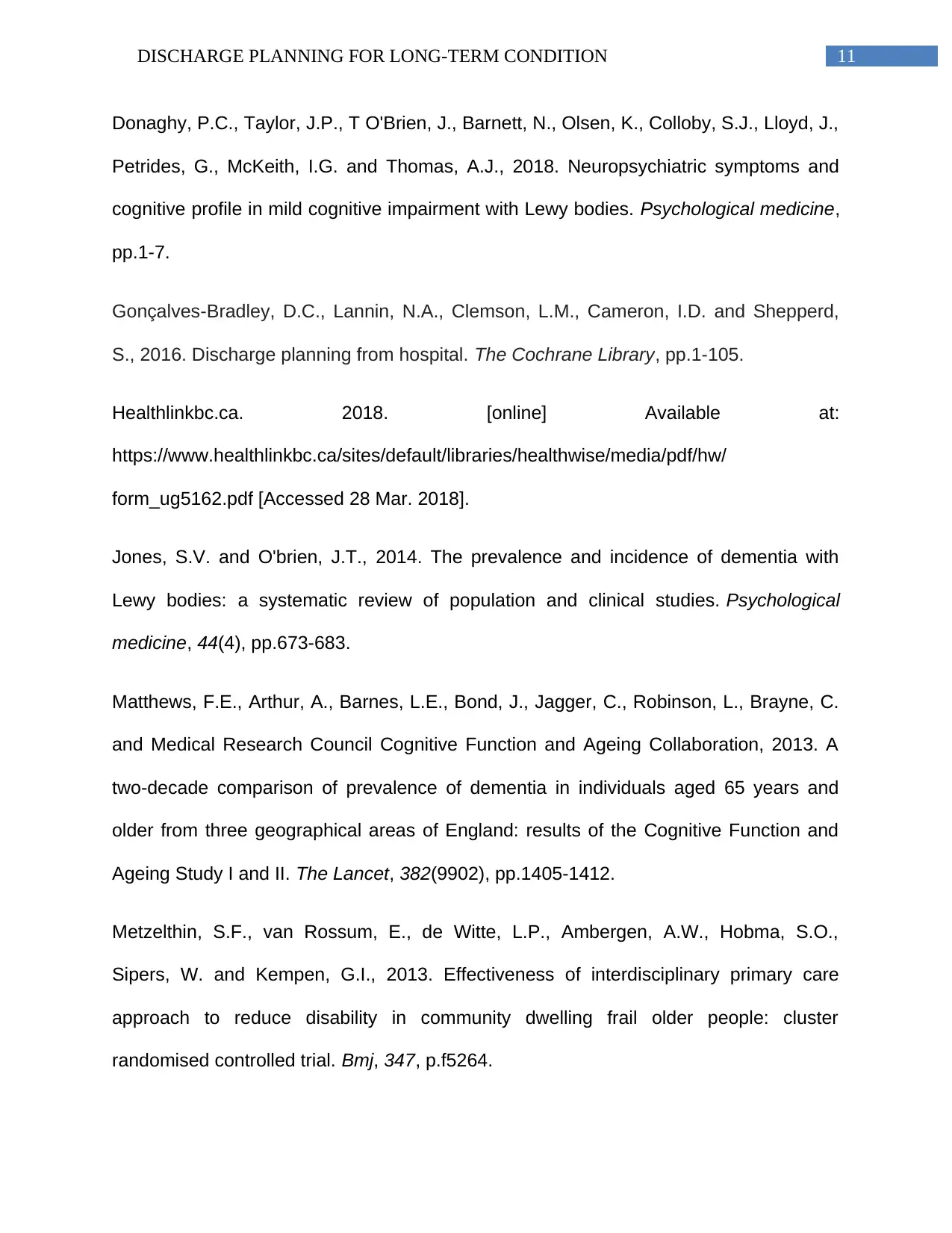
11DISCHARGE PLANNING FOR LONG-TERM CONDITION
Donaghy, P.C., Taylor, J.P., T O'Brien, J., Barnett, N., Olsen, K., Colloby, S.J., Lloyd, J.,
Petrides, G., McKeith, I.G. and Thomas, A.J., 2018. Neuropsychiatric symptoms and
cognitive profile in mild cognitive impairment with Lewy bodies. Psychological medicine,
pp.1-7.
Gonçalves‐Bradley, D.C., Lannin, N.A., Clemson, L.M., Cameron, I.D. and Shepperd,
S., 2016. Discharge planning from hospital. The Cochrane Library, pp.1-105.
Healthlinkbc.ca. 2018. [online] Available at:
https://www.healthlinkbc.ca/sites/default/libraries/healthwise/media/pdf/hw/
form_ug5162.pdf [Accessed 28 Mar. 2018].
Jones, S.V. and O'brien, J.T., 2014. The prevalence and incidence of dementia with
Lewy bodies: a systematic review of population and clinical studies. Psychological
medicine, 44(4), pp.673-683.
Matthews, F.E., Arthur, A., Barnes, L.E., Bond, J., Jagger, C., Robinson, L., Brayne, C.
and Medical Research Council Cognitive Function and Ageing Collaboration, 2013. A
two-decade comparison of prevalence of dementia in individuals aged 65 years and
older from three geographical areas of England: results of the Cognitive Function and
Ageing Study I and II. The Lancet, 382(9902), pp.1405-1412.
Metzelthin, S.F., van Rossum, E., de Witte, L.P., Ambergen, A.W., Hobma, S.O.,
Sipers, W. and Kempen, G.I., 2013. Effectiveness of interdisciplinary primary care
approach to reduce disability in community dwelling frail older people: cluster
randomised controlled trial. Bmj, 347, p.f5264.
Donaghy, P.C., Taylor, J.P., T O'Brien, J., Barnett, N., Olsen, K., Colloby, S.J., Lloyd, J.,
Petrides, G., McKeith, I.G. and Thomas, A.J., 2018. Neuropsychiatric symptoms and
cognitive profile in mild cognitive impairment with Lewy bodies. Psychological medicine,
pp.1-7.
Gonçalves‐Bradley, D.C., Lannin, N.A., Clemson, L.M., Cameron, I.D. and Shepperd,
S., 2016. Discharge planning from hospital. The Cochrane Library, pp.1-105.
Healthlinkbc.ca. 2018. [online] Available at:
https://www.healthlinkbc.ca/sites/default/libraries/healthwise/media/pdf/hw/
form_ug5162.pdf [Accessed 28 Mar. 2018].
Jones, S.V. and O'brien, J.T., 2014. The prevalence and incidence of dementia with
Lewy bodies: a systematic review of population and clinical studies. Psychological
medicine, 44(4), pp.673-683.
Matthews, F.E., Arthur, A., Barnes, L.E., Bond, J., Jagger, C., Robinson, L., Brayne, C.
and Medical Research Council Cognitive Function and Ageing Collaboration, 2013. A
two-decade comparison of prevalence of dementia in individuals aged 65 years and
older from three geographical areas of England: results of the Cognitive Function and
Ageing Study I and II. The Lancet, 382(9902), pp.1405-1412.
Metzelthin, S.F., van Rossum, E., de Witte, L.P., Ambergen, A.W., Hobma, S.O.,
Sipers, W. and Kempen, G.I., 2013. Effectiveness of interdisciplinary primary care
approach to reduce disability in community dwelling frail older people: cluster
randomised controlled trial. Bmj, 347, p.f5264.
⊘ This is a preview!⊘
Do you want full access?
Subscribe today to unlock all pages.

Trusted by 1+ million students worldwide
1 out of 27
Related Documents
Your All-in-One AI-Powered Toolkit for Academic Success.
+13062052269
info@desklib.com
Available 24*7 on WhatsApp / Email
![[object Object]](/_next/static/media/star-bottom.7253800d.svg)
Unlock your academic potential
Copyright © 2020–2025 A2Z Services. All Rights Reserved. Developed and managed by ZUCOL.





